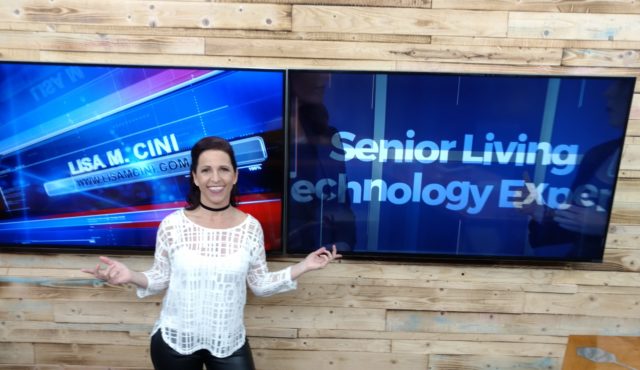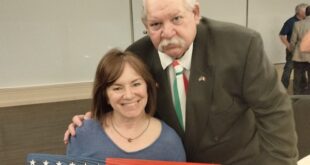Lisa Cini’s design revolutions bring an Italian-American accent to improving Alzheimer’s and dementia care.
“Nursing home” is a contradiction in terms for many Italian Americans, for whom the word “home” conjures images of Sunday dinners surrounded by friends, family and, of course, food.
Lisa Cini grew up amid such celebratory weekends and today fights to bring some of that warmth and spirit to adult care. As an interior designer of long-term care facilities, Cini has become an expert in how design can positively impact those with Alzheimer’s and dementia. She’s also cared for a grandparent with those very conditions — this in a home with four generations under one roof — and writes about it in her book “Hive: The Simple Guide to Multigenerational Living.”
Cini spoke to Lou&A about what inspires her work, the approach she takes to groundbreaking design, and how her Italian heritage and family values gave her career an added dimension of passion and purpose.
Lou&A: Tell us about your Italian lineage.
Lisa Cini: My grandmother’s family on my father’s side is from Sora, in Lazio. I look just like my grandmother when she was younger; her name was Adelina DeCosmo. They called her Della, and I named my daughter Adelina after her. We’ve gone to Sora several times, and I even organized a family reunion there.
Lou&A: What was it like growing up in an Italian household and how did it influence your eventual career?
Cini: My grandmother and her sisters were matriarchs. Every Sunday was a huge dinner with seven to 12 courses. The dining room sat 16 to 20 people in a beautiful Chippendale style; she was the top salesperson at a furniture store. This was after owning a pasta factory with her sisters and then restaurants. Everything revolved around food, and I was mesmerized watching her roll out dough with a broomstick to make hundreds of raviolis in what seemed like seconds. She told me you can’t be mad at someone while you’re eating a great meal.
She married a German — which was quite taboo at the time — but she believed in love and turned him into an Italian with food. The best lesson she taught me was to not be afraid: that it was an Italian thing to bend the rules. When she wanted to develop their farmland and couldn’t get a loan as a woman, she made her brother-in-law his favorite dish and had him go to the bank to say he was her husband so she could get the loan. It turned out well. Hearing stories like this gave me the courage to be an entrepreneur.
Lou&A: What inspired you to mix design and health care?
Cini: Family is first, and my grandparents would’ve rather died than go into senior living. They wouldn’t visit my projects even when I’d won design awards; they were scared we would trap them there. This is why I was determined to design spaces my family would want to live in. Honoring the people that took care of you as they age through interior design seemed the best legacy I could create for my family.
Lou&A: So what does that look like?
Cini: It’s a beautiful environment that feels like home with great food and where friends were welcome. The senior living homes I design are very similar to showing up at my grandmother’s Sunday dinners. It was a blend of ages, family and food where we connected and laughed … but most importantly it was “soul space,” where your soul feels at ease.
Lou&A: What inspired you to make the connection between Alzheimer’s, health and design? In medical care, design is often overlooked.
Cini: When you’re confused, design can make your life a living hell or heaven on earth. I knew there was no greater place I could impact those aging than in dementia and Alzheimer’s design. Designing safe, warm, home-like spaces helped not only those aging but their families as well.
Lou&A: You’ve had four generations living under one roof. That was how Italians lived for centuries. How do you make it work, especially with an Alzheimer diagnosis in the family?
Cini: There are so many tricks, but the key is to have a good sense of humor and not expect it to be perfect. Love and communication are key, but we also use technology a great deal to help with all our needs. I also employed the “LOVE” method of design.
Lou&A: Which is what, exactly?
Cini: L stands for “light”: Have as much natural light as possible, use sensor lights to find your way in the dark and make sure the space is bright enough for senior eyes. O stands for “optimize”: Make things easy with a heat/light combo in the bathroom or a grab bar toilet paper holder. V is “visualize: Use contrast to make the handrail easy to see. We also installed a camera in my grandmother’s living room to make sure she was OK when we were out of the house. And E is “ease”: We opened up a wall in the living room so my grandmother would not get trapped when she was wandering. This helped her not to get frustrated.
Lou&A: You’ve made this fascinating connection between gaming and senior health. What is it you see?
Cini: Everyone loves to play games; they keep us active in our minds and in bodies. The latest research shows your thinking and balance can actually improve. We weren’t designed to be floating heads without activity. Yet as we age — especially in the U.S. — we make that an excuse of not moving. And not moving is actually worse for arthritis.
I spent a summer in Italy researching seniors and found that their ability to walk on cobblestones, climb steps and get their daily groceries kept them much more mentally and physically fit than American seniors. Our ability to buy a month’s groceries at Walmart hurts our need to get out of the house daily. Gaming can connect you with others and exercise your brain and body — improving sleep and mental attitude.
Lou&A: When you look at the path ahead, what would you love to accomplish?
Cini: I purchased the storied Columbus Woodland Manor Mansion and am turning it into a fully functional showplace to highlight the latest technology for multi-generational living. This is not a senior center; it’s designed to be a true community space for events, meetings and classes. It will be beautiful, just like my grandma’s home, with great food and technology to move people from fear to freedom. I’d love to have these all over the country to help families connect, document their legacies in our podcast room, record grandma’s favorite recipes with the Moley robotic kitchen and hold incredible gatherings in the ballroom.
Lou&A: It sounds like there’s quite the link to your heritage and upbringing.
Cini: Creating spaces for seniors that allow them to be their best at any age — and connect with those they enjoy and love — is beautiful. I see it not as one building I’m designing but how many lives the space will positively impact. My family and heritage taught me we’re meant to be connected: to love each other.
To find out more about Lisa Cini’s design work, click here.
The above appears in the November 2019 issue of the print version of Fra Noi. Our gorgeous, monthly magazine contains a veritable feast of news and views, profiles and features, entertainment and culture. To subscribe, click here.
 Fra Noi Embrace Your Inner Italian
Fra Noi Embrace Your Inner Italian






